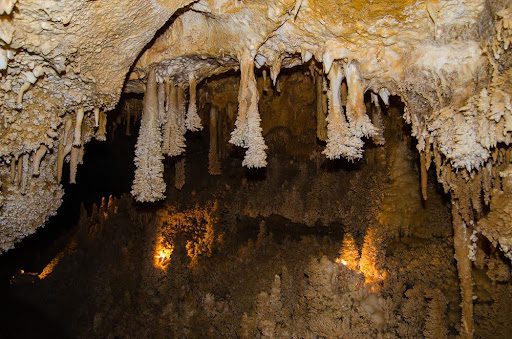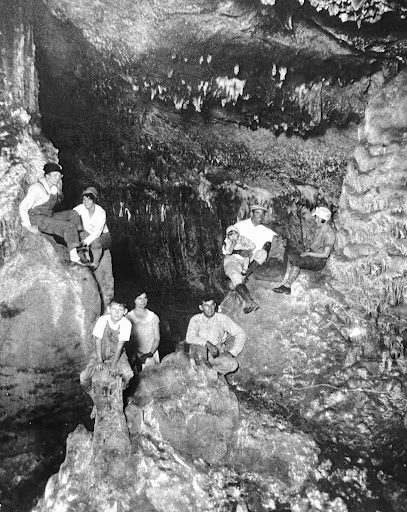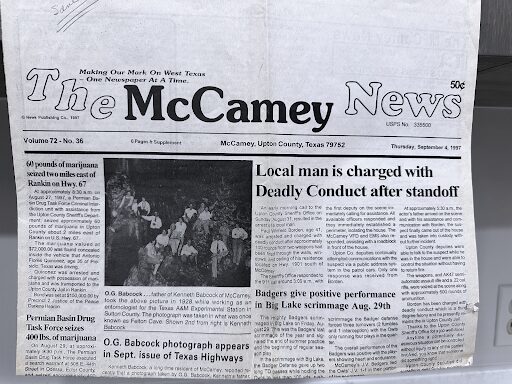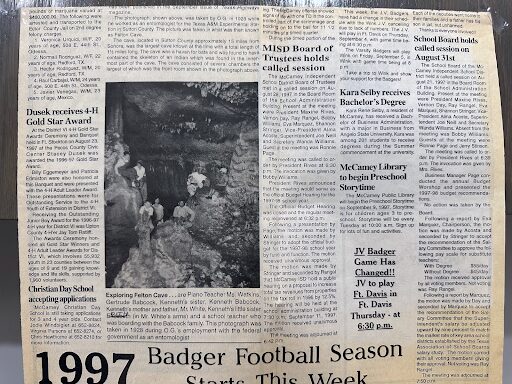
Carlsbad Caverns, New Mexico
“Daddy was sent from time to time for special expeditions related to his job. On one occasion he was sent to Carlsbad Caverns to collect insects found within the cave. This was just after the U.S. Park Service purchased the cave, and several years before it was opened to the public. Daddy brought all our family on that trip, and we had a cabin to stay in at the entrance to the cavern.” Kenneth Babcock
“We accompanied him to the Carlsbad Caverns which were being explored. The government sent him to accompany the explorers and naturalists to discover what insect life could be found. I remember looking down into the depths of that awesome hole, the main entrance cave, seeing the men make the chilling ascent from ledge to ledge on very long ladders.” Gertrude Babcock
“Daddy and Dr. L.H. Bailey were commissioned by the National Geographic Society to do a study on the life in the caverns and Mr. Bailey examined mammalian life. Daddy studied the insect life. The tour in the cave lasted most of three continuous days and included the lower caverns, which was larger than the upper cavern. Only the top cavern is open to the public today.” Kenneth Babcock
*This trip to the caverns occurred in 1924, prior to opening the caves to the public.

Caverns of Sonora, Texas
The Mayfield family began its ranching operations in Sonora, Texas around the turn of the 20th Century. An opening in the rocks was found in the southern part of the ranch when a dog chased a raccoon into this 20-inch opening. Locals began exploring the cave sometime in the early 20’s. They could go back about 500 feet from the entrance to a fifty-foot-deep pit. This section of the cave was eventually known as Mayfield Cave. Decades of exploration followed, hindered by a 50-foot pit just 500 feet in from the entrance. In 1955, Stanley Mayfield gave permission to four cavers from Dallas who discovered a further seven miles, including what are now considered the most scenic areas. Those early explorers eventually fashioned a network of stairs, narrow pathways, and bridges. The caverns were opened for public tours on July 16, 1960.

This brochure was made available when the Caverns of Sonora opened on July 16, 1960.
The Caverns of Sonora were formed by water slowly eroding away the weaker faults and joints in the Edwards Limestone. This process is known as percolation or acidic erosion. After the water table fell below the cave level, air filled the rooms allowing for formation of millions of delicate crystal patterns.
Bill Stephenson, the founder of the National Speleological Society said of the Caverns, “It’s the most beautiful known in the world. Its beauty cannot be exaggerated, even by Texans!”


“During the late “20’s” we explored the cave just outside Sonora. We would go about 1500 feet into the cave as a room fifty feet deep stopped us. In 1956 two spelunkers managed to traverse that deep room, enlarge a hole in the far wall and enter the fabulous Cavers of Sonora. Finances were supplied in promoting the new caverns by a small group of local men. Two spelunkers began developing the first parts of the cave to open to the public. They even slept in the cave, digging impressions for their hips. In about two years they managed to cut a cave exit close to the main building. These caves are known to be one of the most beautiful sites in the world and visitors come from all over to see them. As yet, it is still privately owned, although the State of Texas reportedly has tried to buy it.” Kenneth Babcock

“This cave (Felton Cave) was thoroughly explored by my father. It became a favorite cave for introducing others to the sport of spelunking. Since our family took in two lady schoolteachers to room and board each year, we felt it was of importance to entertain them, so we took them to the Felton Cave. The cave had residents such as bats and daddy long-leg spiders. The ladies naturally screamed when bumped by a bat or when rubbed up against a stack of pulsating daddy long-leg spiders, adding to my fun. Another thrill was entering the cave when clambering over the large rocks at the entrance of the cave. Rattlesnakes under the large rocks became disturbed and would begin rattling under us. That was scary for me, as well as others.”
Kenneth Babcock





The photographs in this article were taken by O.G. Babcock in 1928. He was employed as an entomologist for the Texas A&M Experimental Station in Sutton County. The picture was taken in what was then known as Felton Cave. The cave, located in Sutton County approximately 15 miles from Sonora, was the largest cave known at the time with a total length of 1.5 miles. The cave was a haven for bats and was found to contain the skeleton of an Indian which was found in the innermost part of the cave. The cave consisted of several chambers, the largest of which was the front room shown in the photograph above.
